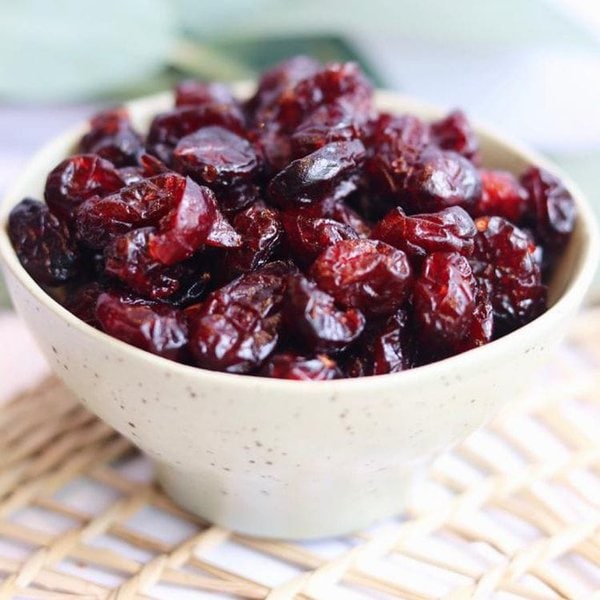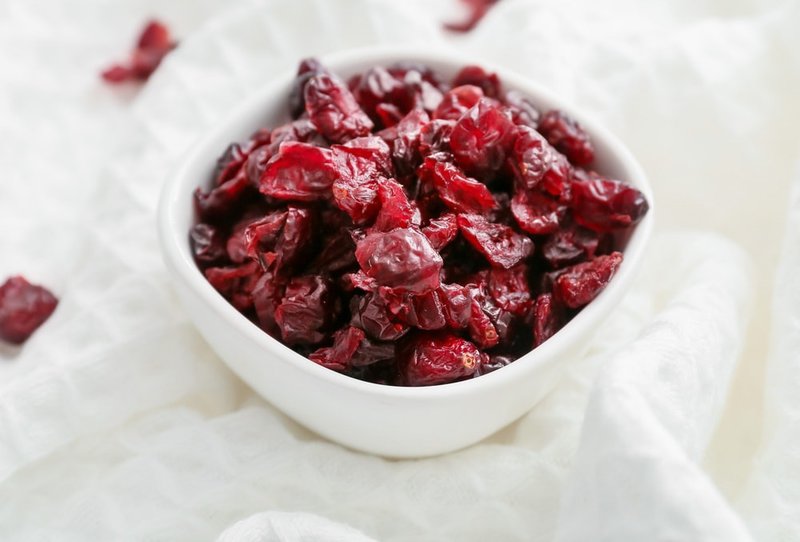Cranberries pop up in many recipes and help contribute to various delicious meals, especially during Thanksgiving and Christmas. But in such festive seasons, whether your pooch should be participating in the merriment and eating cranberries present in different dishes is a pertinent health-related question that mustn’t go unanswered.
You can easily find cranberries, especially the dried variations, at local stores, and Craisins is one of the well-known brands in the country. Then again, attempting to answer the first question only begets another: exactly what type of cranberries should dogs consume? And, if cranberries have their moisture content removed, would it still be safe for dogs to eat such?
Dogs can eat dried cranberries, and they should. It is because cranberry fruit contains nutrients highly beneficial to your furry buddy, like vitamin C. As with all other fruits, moderation is vital, and dried cranberries, or Craisins, are typically loaded with sugar. This may lead to diarrhea in dogs when overconsumed.
What’s more, additives and chemicals used in preserving Craisins aren’t dog-friendly and could be detrimental to your pooch’s vitality. This article contains helpful information that explains the difference between fresh and dried cranberries, the health benefits of dried cranberries in dogs, why too many dried cranberries are bad for dogs, how to prepare dried cranberries for dogs, and lots more.
Fresh Cranberries VS Dried Cranberries: Which Is Safe For Dogs?
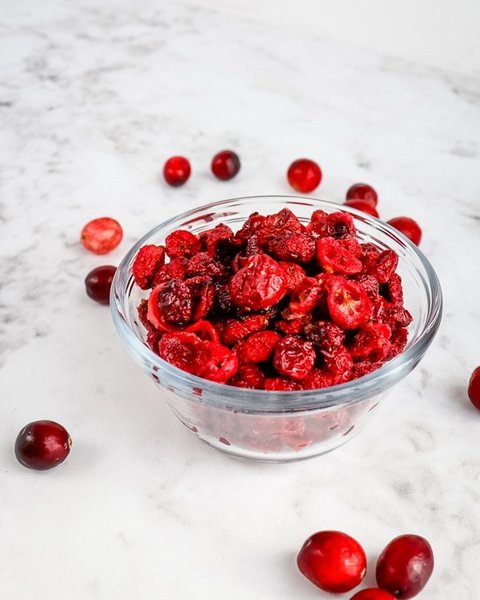
Whether eaten fresh or dried, cranberries remain a great source of nutrition for dog consumption.
The issue with dried cranberries is that the dehydration process leaves the fruit extremely tart, necessitating the need to mask the tangy taste by swamping the berries in sugar.
The sweetening and preservation processes involved in making dried cranberries diminish the original nutritious quality and make this fruit’s dried variant unhealthy for consumption beyond moderate levels.
Naturally, dehydrated cranberries have very little sugar in them. However, processed dried cranberries, like Craisins, and aren’t exactly suitable for dogs.
Are Dried Cranberries Good For Dogs?
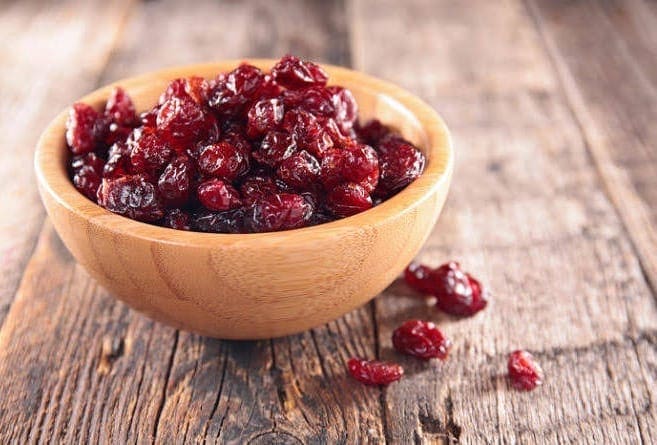
Many fruits could be toxic to dogs, but dried cranberries aren’t one of them. These sharp-tasting red berries pack a whole lot of health benefits that many experts have safely recommended for humans and dogs.
For clarity, let’s look at some of the fantastic qualities that make dried cranberries a wonder fruit for your canine pal.
Contains Anti-Aging Antioxidants
Loads of antioxidants abound inside a dried cranberry fruit. Antioxidants are essential because they help to fight off the corollary effects of metabolism.
Certain free radicals exist as by-products of the natural biological activities in a dog’s body systems. Gradually, as a dog ages, these free radicals start to multiply in numerous folds, causing massive destruction to cells and organs.
The telltale signs of overabundant free radicals are rapid aging and inflammatory diseases like arthritis.
Luckily, dried cranberries contain antioxidants like quercetin and polyphenol that counterbalance the side effects of rapid metabolism and prevent quick aging.
Reduces Urinary Tract Infection
Perhaps, the utmost reason why cranberries are incredibly beneficial to dogs is to prevent urinary tract infections or UTIs.
UTI occurs when bacteria like Escherichia coli spread across a dog’s bladder walls. The accumulation of E. coli in the bladder causes a stinging and painful sensation during urination.
Recent research by the FDA —Food and Drug Administration— shows that dried cranberries could stop the multiplication of bacteria in the bladder when ingested in moderate proportions. And that’s because every cranberry fruit contains a unique substance called D-mannose, which possesses antibacterial properties that combat the spread of E. coli.
Prevents Carcinogenesis
Dried cranberries contain phytochemicals and other anti-carcinogenic compounds that slow down the growth of cancer cells.
Interestingly, dried cranberry fruit not only reduces the spread of cancer-causing cells but also contains substances that prevent the occurrence of stomach cancer in dogs.
Furthermore, research has shown that using cranberries as supplementary nutrition during cancer treatment helps speed up the recovery rate.
Aids Digestion And Boosts Immunity
Dried cranberries, like most fruits, contain fiber that enhances the digestive process in dogs. But, what makes these berries more powerful is their ability to fight off bacteria, fungi, and viruses in the gut.
Given the powerful triple effect that the cranberry fruit delivers in conjunction with increased digestibility in dogs, your furry buddy is less likely to become ill with frequent dog treats using dried cranberries.
Helps Dogs With Diabetes
Dried cranberries, the unsweetened versions, have a naturally low sugar content that helps to balance out blood sugar levels in your four-legged pal’s system. So, if your doggie is battling with diabetes, including dried cranberries as a regular treat is a great way to help regulate its blood glucose level.
Will Dried Cranberries Hurt Dogs?
Dried cranberries could either be sweetened or unsweetened, and depending on which type your beloved canine consumes, varying symptoms may arise.
Some of which are:
Kidney Stones
Kidney stones occur in dogs when there’s an increased concentration of oxalates that arise from the decomposition of dehydroascorbic acid, which is another fancy word for oxidized vitamin C.
Recall that dehydrated cranberries have very high acidic and vitamin C content. As such, the overconsumption of dried cranberries can lead to an increased level of oxalates, resulting in the likely formation of kidney stones.
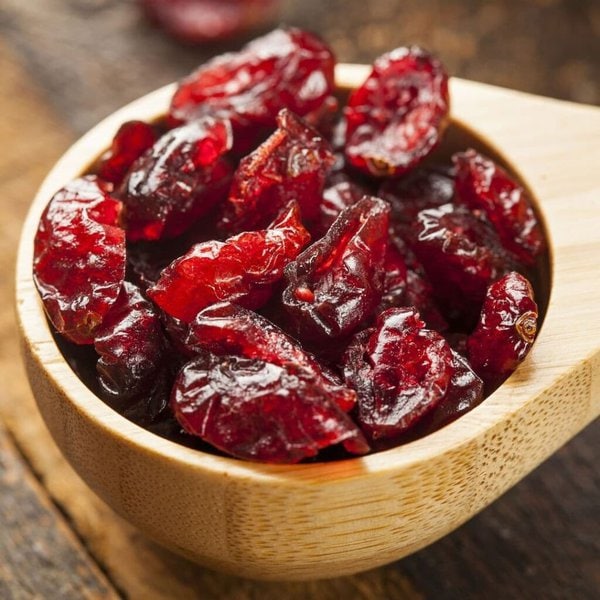
Allergy
Dogs with high allergy susceptibility could react badly to dried cranberries. Allergies could cause a host of symptoms that run the gamut from mild to life-threatening, such as skin irritation and stomach upsets.
Gastrointestinal Discomfort
Ideally, the high fiber content in dehydrated cranberries makes for a smooth digestive process in dogs. Conversely, when taken in excess, the massive fiber levels in dried cranberries start to become counterproductive, upsetting proper stomach function, which leads to diarrhea, abdominal pains, and swellings.
Reduces Blood Sugar Level
Hypoglycemia—the occurrence of low blood sugar—is as dangerous, if not more, as hyperglycemia—high blood sugar in dogs.
Dried cranberries have a low glycemic index that greatly reduces the amount of glucose in the blood, which is a good thing in diabetic dogs. However, the flip side could lead to dizziness and unconsciousness, and when left untreated, death.
How To Make Dried Cranberries For Your Dog?
The best types of dried cranberries are homemade. However, preparing dried cranberries at home gives you total control in determining the degree of dryness and amount of sugar contained in each bowl.
Here’s a quick way to prepare Craisins at home for your pooch:
First, buy the fresh cranberries from the market, wash them, and heat them in a pan with low heat for 5 to 10 minutes. You can add any sweetener or sugar so long it’s not too much to harm your pooch.
Second, take out the soft berries, and squish them with a ladle. The essence of this is to release trapped air and soluble fiber that could hinder the drying process in each berry.
Third, preheat your oven to 170 °F, spread the popped berries on parchment paper inside a baking pan, and slot the pan into the oven.
After 3 to 4 hours, take out the pan, change the parchment paper, stir the berries and leave them to dry for another 1 to 2 hours, depending on the degree of dryness you want.
Once ready, bring out the dried cranberries and store them in a container in the freezer, from where you can occasionally fetch some as dog treats for your canine companion.
How To Feed Dried Cranberries To Dogs?
Consuming dried cranberries isn’t dangerous and shouldn’t constitute a health hazard for dogs unless it’s a processed version that contains fructose syrup and other chemical sweeteners. Unfortunately, such types of dried cranberries aren’t fit for your canine pal because they often have different kinds of unhealthy fruits and additives mixed.
You’ll need to feed the berries one at a time if you’re introducing them to your pooch for the first time. Also, endeavor to monitor your dear Fido for any strange signs resulting from the consumption of dried cranberries.
A general rule of thumb is to feed fewer berries to smaller dog breeds like the Papillon and the Poodle to avoid overtasking their frail digestive systems.
You could also add the berries as toppings in meals or as a sauce made from other non-harmful fruits. Endeavor not to overindulge by keeping treats down to 10% of your doggie’s meal intake.
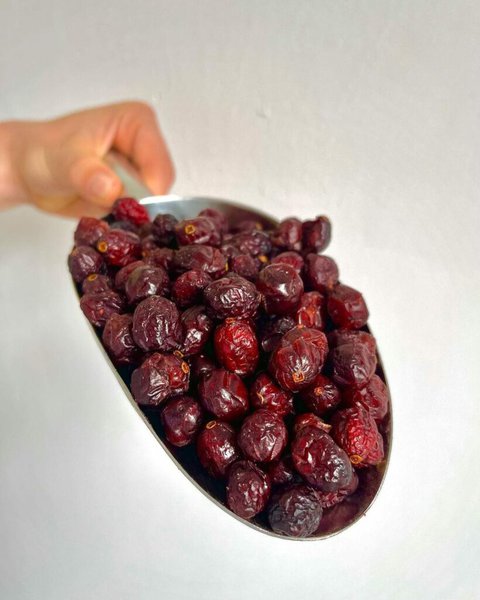
What To Do When My Dog Eats Craisins?
Should your furry companion hoover up one or two berries that fall off the dining table, there’s no cause for alarm. But say it gobbled up a whole packet of Craisins, then you’ll need to be worried about either of two outcomes or even both.
The first outcome could be minor, such as vomiting and stooling, which indicates that a dog’s system is trying to get rid of sugar overload.
The second outcome, which is worse, occurs when the Craisins ingested contain excess sugar and other fruits that pose serious health risks for your dear Fido.
Can Dogs Use Cranberry Supplements?
Yes, cranberry supplements have been proven to be absolutely beneficial to dogs. First, because they function as supplements, they should contain all the important vitamins in high concentrations that diffuse into the bloodstream rapidly when consumed.
Second, since it comes in a tablet, it is easier for your dear Fido to ingest without you worrying about the unpalatability of natural dried cranberries.
Always ensure that you consult your vet before administering supplements to your four-legged pal, as dogs react differently to substances.
